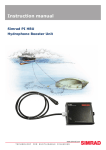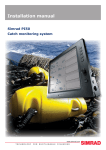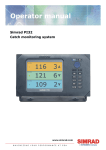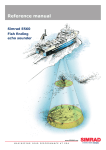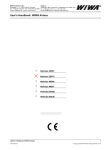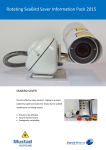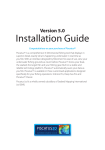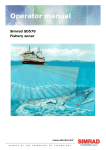Download Simrad PI30 Instruction manual
Transcript
PI30 Quick reference guide Keypad buttons Graphic display MENU - turns the menu on and off. Press to hide the displayed menu without making a selection. ENT - turns the cursor on and off, opens parameters for the insertion and confirms data. Select setup directly from the chosen display. D1 to D3 - identifies which sensor corresponds to the data window (background colour) and subsequent bar and line graph information. Minus (-) Plus (+) - selects available values, scales and ranges. Multi-direction button - controls the cursor’s location in activated menus and displays, moves the VRM. m - indicates that sensor depth is shown in meters or the sinkrate is in m/min. PWR - turns on the unit, press until the display is visible. Adjusts LCD brightness, contrast, display colour and keypad illumination. Press twice to turn off the unit. WIN - changes between one of the four selected windows. Press when the desired window is displayed to select. Press and hold for more than two seconds to actuate automatic window rotation, press again to return to normal operation. Time scale - is selected in Graphic setup. Sensor attachment and placement Sensor(s) attached near the surface will indicate if the net submerges when purs- Data window 2 Data window 3 Depth scale - can be decreased or increased using the respective - or + buttons on the keypad. Line graph - provides a depth and sinkrate profile for the net. Line thickness is selected in the Graphic setup. Refer to the PI30 Instruction manual for more information concerning echo sounder and navigation keypad functions. PS30 sensors are preferably attached to the net’s bridle and suspended freely so that they point vertically when pursing. Data window 1 Bar graph - displays a “side view” of the net’s depth. An echogram may be superimposed on the Graphic display when an echo sounder transducer is installed. (857-164315A / AA000 /37-26) D3 Which ever method of attachment is chosen, PS30 sensors must be protected against unnecessary shock when shooting the net. Information from the sensors (D1, D2 and D3) is displayed in the corresponding data windows (1, 2 and 3) with differently coloured backgrounds to facilitate interpretation. D2 D1 A complete overview of the fishing operation is achieved using three PS 30 depth sensors, permanently labelled D1, D2 or D3 and attached to the purse seine as illustrated above. Once deployed, the sensors begin transmitting automatically. Alarm limits - both the upper and lower limits are displayed. Numeric display D1 to D3 - indicates which depth sensor corresponds to the data window. Sensor depth - is rounded to the nearest meter for depths over 100 m, otherwise it is displayed to one decimal place. Maximum depth is 290 m. m - indicates that the depth is shown in meters. When purse seining for tuna, PS30 sensors should be attached to the net’s footrope (refer to the Instruction manual). Sensor information - displays actual sensor depth or sinkrate (selected in the Graphic setup). Data window 1 Graphic alarm - the arrows’ direction indicates if the net depth should be increased or decreased with regard to the selected alarm limits. Graphic alarms may be accompanied with or without audible alarms. Yellow pulse lamp - blinks each time a signal is received from the respective sensor. Rise/sink rate - is displayed in the selected units per minute. Values near 0 indicate that the net has stopped sinking. Data window 2 Data window 3 Interference signal - displayed when nearby vessel(s) operate on the same channel or with other hydroacoustic equipment. Contact your Simrad dealer to select a different sensor frequency should this problem persist (see MP filter on side two). WORLDWIDE MANUFACTURER OF MARINE ELECTRONICS Arrows - indicate if the net is either rising or sinking. Here the net is sinking at a rate of 12 m/min. Sensor maintenance, programming and calibration Status display Hydrophone cable information: - Black = break - Red = short circuit - Yellow = OK Data window 1 Data window 2 Data window 3 The Status display shows sensor data, signal thresholds and background noise levels providing an overview of present hydro-acoustical conditions and the margin for reliable signal detection. Other information displayed includes cable status, program version, and echo sounder / position information if the necessary equipment is connected. Data window information: -Sensor depth -Sensor identification -Units of depth -Pulse lamp condition SW - software version E - error message CH/R - channel The red field shows the signal level that is over the detection threshold, DT. The green field over the noise reference level shows the detection threshold, DT. Average noise reference levels. Frequency spectrum - for frequencies on the 00 - 15 band. Select the desired band by pressing the respective - or + buttons on the keypad (wait for the unit to update the display). The graph represents background noise and signal strength of the frequency band selected. Information from an interfaced GPS or integrated echo sounder if the unit is connected to a transducer. Installation / Configuration / Receiver parameters Defines sensors 1 to 3 and keeps track of their attachment locations to the net. Select the channel shown on the sensors’ labels and/or the visual LED identification signal displayed when turned on. Note the sensor configuration for later reference. AGC - recommended to be ON. Under favorable noise conditions manual gain adjustment may provide increased range. MP filter - reduces excessive echo return or interference from other hydro-acoustic equipment operating on the configured channel where the sensor is not in use. Max shooting speed - compensation for doppler shift when shooting the net. Maximum speed may be limited by channel separation. Effective only when the vessel is in motion. MPF level - is activated when the MP Filter is ON. Reduce the MPF level value in small steps to increase the filter ’s effectiveness. Avoid reducing the level so low that the sensors’ signals are also blocked. Detection threshold increases the DT if false signals are detected on a channel where a sensor is in use. A high DT indicates that only the strongest signals will be received. A low DT may provided a longer range under favorable conditions. The PI30 must receive at least four pins when first powered up to generate data. Should one or two pings be missing, the predicted value will be displayed in grey. If the signal is lost, *.* is displayed. Sensor filter: - OFF = no effect (fastest update of data) - Light = average of the last four pings - Heavy = average of the last eight pings Maintenance - rinse sensors with fresh water to avoid depleting their batteries after use. A saltwater film on the exterior of a sensor can complete the circuit from the sea water detector to a fastening lug. This phenomenon may also cause the red LED on the sensor charger not to illuminate when a sensor’s battery is deeply depleted. To remedy this problem, wash the sensor with fresh water and wait several minutes. The sensor may then be charged as described under “Charging”. Programming - of sensors is accomplished using a PC connected to their charging/ fastening lugs. To program a sensor both the software, Simrad number: 889-24037 and a special cable number: 380-204728 are required. The dealer is normally responsible for programming the various channel selections and other functions. Other depths - if the sensor is programmed to start at a depth of 2 m, it should be suspended at 3 m during the calibration procedure. Calibrate the sensor as described and note the offset values. Reduce the offset values by 2 m after calibration. Calibration - is performed on board the vessel to set the sensors’ reference levels to one meter as follows: Suspend the sensors over the side of the vessel individually or together at a depth of one meter, the draft plus one meter or the reference level that is to be defined as one meter. Once the sensors’ depth readings have stabilised, set the Calibration parameter to YES. Sensor calibration takes one minute and the data will be temporarily displayed as grey during this time. Once the process is complete, the data will again be displayed in black with updated offset values and a depth of one meter. Note: Sensors not submerged in saltwater will not be calibrated. Charging and testing A fully depleted sensor (representing about 30 hours of continuous service) must be charged for at least 16 hours to restore its battery to full capacity. Optimal charging temperature is from +10ºC to 25ºC. Never charge sensors at temperatures below freezing. Sensor 1, 2 or 3 Channel 1 to 30 Warning! The use of chargers not specified by Simrad may lead to personal injury and/or material damage. Positive charging/ fastening lug (+) Negative charging/ fastening lug (-) Sea water detector (serial no 300 and above) Charging - connect the red and black alligator clamps to the positive and negative fastening lugs labelled “+” and “-” respectively. Check that the charging lamp on the sensor charger is illuminated and that the sensor being charged blinks every four seconds. If it does not blink in this manner (indicating charging mode), the battery will not be fully charged. Note: Never charge a sensor with wet rope in contact with the fastening lugs. Testing - touch the sea water detector (serial no below 300: touch the cover) and a fastening lug at the same time. This will cause the sensor to switch ON and identify the channel it transmits on with a series of blinks (see the Instruction manual) and begin sending data if it is not programmed differently. • If the sensor does not blink when switched ON, it indicates a depleted battery and should be charged for a few minutes and tested again. If it blinks and begins to send data, it should be charged for at least 16 hours. • If the sensor continues to just blink when switched ON it indicates a close to empty battery. Charge the sensor for 10 minutes and test. If it resume normal operation, charge for ~ 16 hours. • If the sensor repeats the start up blinking sequence with a four seconds interval, it indicates fault with the depth cover. Contact your nearest Simrad dealer.


